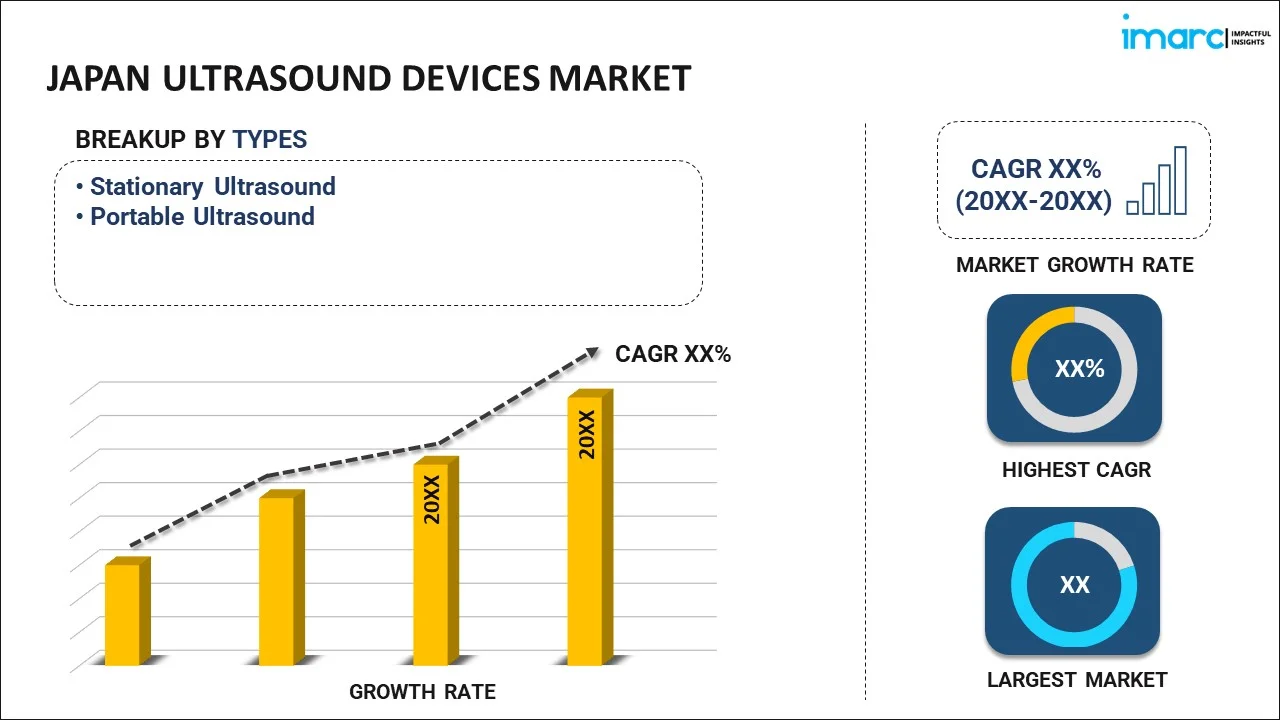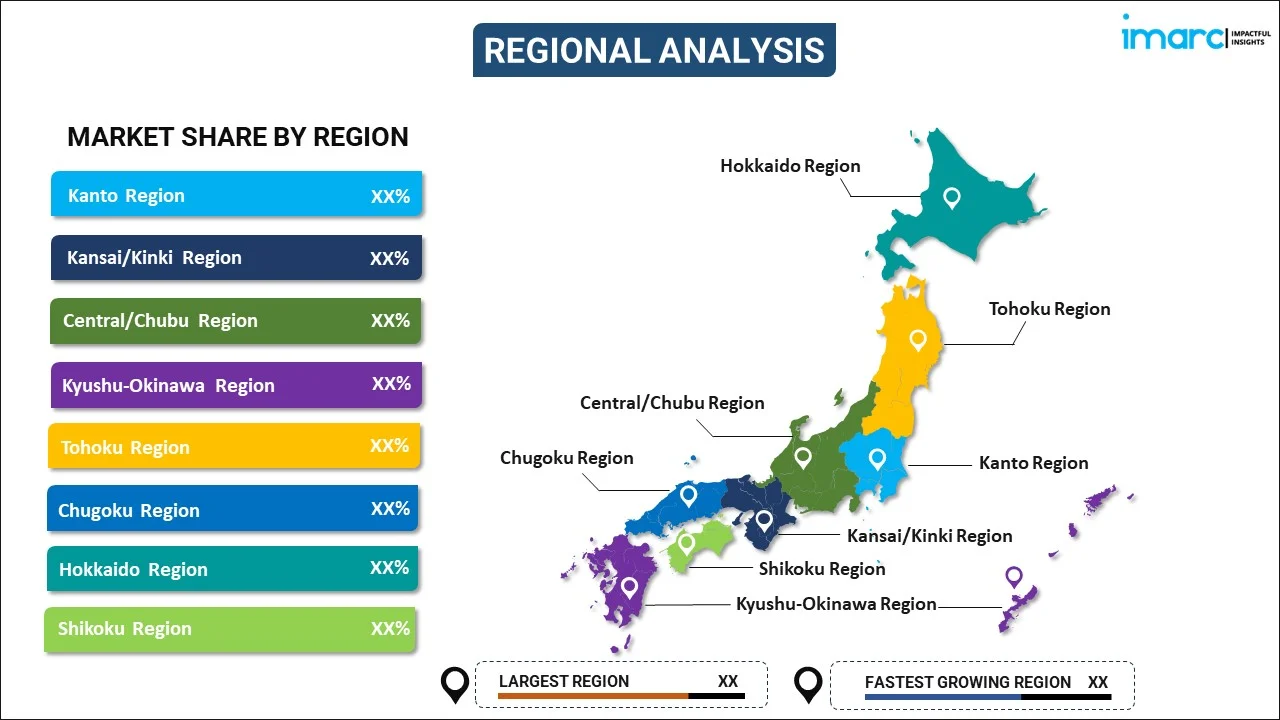
Japan Ultrasound Devices Market Report by Type (Stationary Ultrasound, Portable Ultrasound), Technology (2D Ultrasound Imaging, 3D and 4D Ultrasound Imaging, Doppler Imaging, High-Intensity Focused Ultrasound), Application (Anesthesiology, Cardiology, Gynecology/Obstetrics, Musculoskeletal, Radiology, Critical Care, and Others), and Region 2025-2033
Market Overview:
Japan ultrasound devices market size reached USD 551.0 Million in 2024. Looking forward, IMARC Group expects the market to reach USD 887.0 Million by 2033, exhibiting a growth rate (CAGR) of 5.4% during 2025-2033. The growing demand for diagnostic imaging and treatment, along with the increasing adoption of minimally invasive surgery, is primarily augmenting the market growth.
|
Report Attribute
|
Key Statistics
|
|---|---|
|
Base Year
|
2024
|
|
Forecast Years
|
2025-2033
|
|
Historical Years
|
2019-2024
|
| Market Size in 2024 | USD 551.0 Million |
| Market Forecast in 2033 | USD 887.0 Million |
| Market Growth Rate 2025-2033 | 5.4% |
An ultrasound device, often termed a sonogram, is a medical apparatus that captures live images from inside the body using elevated-frequency acoustic waves. It enables healthcare specialists to detect issues related to the bladder, eyes, gallbladder, kidneys, liver, ovaries, pancreas, spleen, thyroid, testicles, uterus, and vascular systems without resorting to surgical intervention. Furthermore, it's pivotal in monitoring fetal development during gestation because, unlike other imaging methods, ultrasound doesn't depend on radiation. Additionally, it facilitates the precise positioning of a needle for procedures like biopsies or tumor therapies, investigates breast abnormalities, inspects the thyroid organ, identifies genital and prostate complications, and assesses conditions related to bone metabolism.
Japan Ultrasound Devices Market Trends:
The Japan ultrasound devices market, an integral component of the nation's healthcare sector, has been witnessing remarkable advancements in recent times. Anchored by Japan's longstanding tradition of technological innovation and precision, the ultrasound market has seen rapid developments both in terms of equipment capabilities and diagnostic applications. One of the salient trends in this space is the shift towards portable and compact ultrasound devices. These devices are not only more convenient for medical professionals but also cater to the needs of remote areas or situations where immediate imaging is crucial. Moreover, 3D and 4D imaging technologies have gained traction, offering more detailed and dynamic visualizations, especially beneficial in obstetrics and cardiology. Another noteworthy development is the integration of artificial intelligence (AI) and machine learning in ultrasound imaging. These technologies aid in image optimization, anomaly detection, and predictive analytics, ensuring quicker and more accurate diagnoses. Driving the market is Japan's aging population, which necessitates increased medical attention and routine screenings, where ultrasound plays a pivotal role. Furthermore, the country's robust healthcare infrastructure and investment in medical research and development provide fertile ground for the adoption of advanced ultrasound technologies. Government initiatives, promoting preventive healthcare and regular check-ups, also act as significant catalysts. In conclusion, the Japan ultrasound devices market, characterized by technological advancements and responsive to demographic and healthcare trends, promises sustained growth and innovation in the foreseeable future.
Japan Ultrasound Devices Market Segmentation:
IMARC Group provides an analysis of the key trends in each segment of the market, along with forecasts at the country level for 2025-2033. Our report has categorized the market based on type, technology, and application.
Type Insights:

- Stationary Ultrasound
- Portable Ultrasound
The report has provided a detailed breakup and analysis of the market based on the type. This includes stationary ultrasound and portable ultrasound.
Technology Insights:
- 2D Ultrasound Imaging
- 3D and 4D Ultrasound Imaging
- Doppler Imaging
- High-intensity Focused Ultrasound
A detailed breakup and analysis of the market based on the technology have also been provided in the report. This includes 2D ultrasound imaging, 3D and 4D ultrasound imaging, doppler imaging, and high-intensity focused ultrasound.
Application Insights:
- Anesthesiology
- Cardiology
- Gynecology/Obstetrics
- Musculoskeletal
- Radiology
- Critical Care
- Others
The report has provided a detailed breakup and analysis of the market based on the application. This includes anesthesiology, cardiology, gynecology/obstetrics, musculoskeletal, radiology, critical care, and others.
Regional Insights:

- Kanto Region
- Kansai/Kinki Region
- Central/ Chubu Region
- Kyushu-Okinawa Region
- Tohoku Region
- Chugoku Region
- Hokkaido Region
- Shikoku Region
The report has also provided a comprehensive analysis of all the major regional markets, which include Kanto Region, Kansai/Kinki Region, Central/ Chubu Region, Kyushu-Okinawa Region, Tohoku Region, Chugoku Region, Hokkaido Region, and Shikoku Region.
Competitive Landscape:
The market research report has also provided a comprehensive analysis of the competitive landscape in the market. Competitive analysis such as market structure, key player positioning, top winning strategies, competitive dashboard, and company evaluation quadrant has been covered in the report. Also, detailed profiles of all major companies have been provided.
Japan Ultrasound Devices Market Report Coverage:
| Report Features | Details |
|---|---|
| Base Year of the Analysis | 2024 |
| Historical Period | 2019-2024 |
| Forecast Period | 2025-2033 |
| Units | Million USD |
| Scope of the Report | Exploration of Historical and Forecast Trends, Industry Catalysts and Challenges, Segment-Wise Historical and Predictive Market Assessment:
|
| Types Covered | Stationary Ultrasound, Portable Ultrasound |
| Technologies Covered | 2D Ultrasound Imaging, 3D and 4D Ultrasound Imaging, Doppler Imaging, High-Intensity Focused Ultrasound |
| Applications Covered | Anesthesiology, Cardiology, Gynecology/Obstetrics, Musculoskeletal, Radiology, Critical Care, Others |
| Regions Covered | Kanto Region, Kansai/Kinki Region, Central/ Chubu Region, Kyushu-Okinawa Region, Tohoku Region, Chugoku Region, Hokkaido Region, Shikoku Region |
| Customization Scope | 10% Free Customization |
| Post-Sale Analyst Support | 10-12 Weeks |
| Delivery Format | PDF and Excel through Email (We can also provide the editable version of the report in PPT/Word format on special request) |
Key Questions Answered in This Report:
- How has the Japan ultrasound devices market performed so far and how will it perform in the coming years?
- What has been the impact of COVID-19 on the Japan ultrasound devices market?
- What is the breakup of the Japan ultrasound devices market on the basis of type?
- What is the breakup of the Japan ultrasound devices market on the basis of technology?
- What is the breakup of the Japan ultrasound devices market on the basis of application?
- What are the various stages in the value chain of the Japan ultrasound devices market?
- What are the key driving factors and challenges in the Japan ultrasound devices?
- What is the structure of the Japan ultrasound devices market and who are the key players?
- What is the degree of competition in the Japan ultrasound devices market?
Key Benefits for Stakeholders:
- IMARC’s industry report offers a comprehensive quantitative analysis of various market segments, historical and current market trends, market forecasts, and dynamics of the Japan ultrasound devices market from 2019-2033.
- The research report provides the latest information on the market drivers, challenges, and opportunities in the Japan ultrasound devices market.
- Porter's five forces analysis assist stakeholders in assessing the impact of new entrants, competitive rivalry, supplier power, buyer power, and the threat of substitution. It helps stakeholders to analyze the level of competition within the Japan ultrasound devices industry and its attractiveness.
- Competitive landscape allows stakeholders to understand their competitive environment and provides an insight into the current positions of key players in the market.
Need more help?
- Speak to our experienced analysts for insights on the current market scenarios.
- Include additional segments and countries to customize the report as per your requirement.
- Gain an unparalleled competitive advantage in your domain by understanding how to utilize the report and positively impacting your operations and revenue.
- For further assistance, please connect with our analysts.
 Inquire Before Buying
Inquire Before Buying
 Speak to an Analyst
Speak to an Analyst
 Request Brochure
Request Brochure
 Request Customization
Request Customization




.webp)




.webp)












